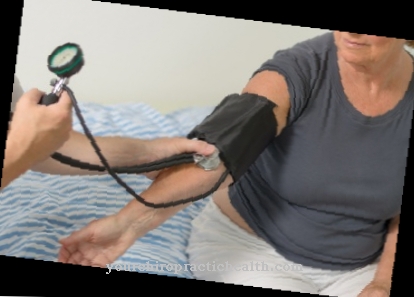Of the AT1 antagonist is used to lower blood pressure and against heart failure. It is a group of different active ingredients, but they all have the same goal.
What is the AT1 antagonist?

The AT1 antagonist, technically referred to as angiotensin 1 receptor antagonist, has been available since 1995. The preparation usually appears in the consistency of a fine powder and is administered as a capsule or tablet. This represents a further development of the ACE inhibitor that has been in use for many years.
It should also be used initially in the case of chronic high blood pressure. If there are no effects or if the person concerned tends to be intolerant, a therapeutic change is made regularly.
A drug from the group of AT1 antagonists would now be preferred. Within these healing substances, however, deviations in the mode of action can be recognized. Some substances of the genus are therefore administered against high blood pressure, others rather against heart failure. All remedies that are more often grouped under the term sartans therefore differ fundamentally in their structure.
Pharmacological effect
The so-called AT1 receptor can be detected in many organs of the human body. These are, for example, the brain, the kidneys, the heart or the complex system of blood and lymph vessels.
From this position the receptor influences various activities of the organs. It is thus involved in the narrowing and widening of the blood vessels, but can also help determine the ability to contract - contractility - of the heart muscle. This vital work also changes blood pressure. The stronger the AT1 receptor, the more blood it presses through the veins and vessels.
However, this can lead to chronic ailments. They are treated by the AT1 antagonist that couples to the receptor. In this way, the AT1 receptor will no longer produce certain hormones in the amount previously determined. The contractility of the heart decreases - although this property can vary within the group of sartans.
As a result, the blood pressure drops to a normal level. However, due to the cardiac changes, the therapy should be accompanied by a doctor and, in severe cases, may require inpatient treatment.
Medical application & use
In general, the AT1 antagonists are mainly administered when the patient suffers from high blood pressure. In the follow-up care of a heart attack, the drug can also ensure recovery in the heart area. It is also conceivable to take it in all cases of heart failure.
In addition, the AT1 antagonists can even be found in the treatment of diabetes mellitus, which is mainly due to a malfunction of the kidneys.
However, there are some peculiarities, particularly with regard to heart disease and increased blood pressure. In these situations the AT1 antagonist is only used with secondary importance. This happens when previous therapy with an ACE inhibitor was unsuccessful. Likewise, if the patient has an individual intolerance to this preparation.
An alternative must now be used. She is seen in the group of sartans. The subordinate use is mainly due to the fact that the ACE inhibitors regularly cause fewer side effects compared to the AT1 antagonists.
Risks & side effects
The AT1 antagonists often cause mild side effects in patients. This can include dizziness and general malaise. Headaches are also one of the frequently observed consequences.
A small number of those affected also complain of an increased cough and sometimes even breathing problems. However, these undesirable side effects usually end a few days after taking the medication for the first time.
The cancer risk, on the other hand, is more serious. According to a study from 2010, patients who had already successfully survived a tumor tended to have the cancer return more frequently through the consumption of sartans. In this case, the further procedure should be discussed with a specialist before prescribing.
In addition, the AT1 antagonist cannot be administered in any case in the presence of certain diseases such as kidney problems, defects in the function of the heart valves or during pregnancy and breastfeeding.












.jpg)



.jpg)










.jpg)
